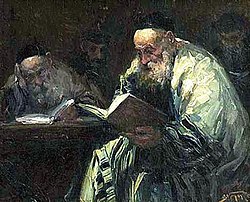|
Jewish Rabbi Studies the Talmud Medal
1973 Proof Gilt (Gold Plated) Silver 38mm (26.64 grams) Sterling 0.925 Purity Silver
Jewish Rabbi studies the Talmud.
Blind Justice standing facing holding scales and sword with information about Talmud to right.
You are bidding on the exact item pictured, provided with a Certificate of Authenticity and Lifetime Guarantee of Authenticity.
In Judaism, a rabbi /ˈræbaɪ/ is a teacher of Torah. The basic form of the rabbi developed in the Pharisaic and Talmudic era, when learned teachers assembled to codify Judaism’s written and oral laws. The first sage for whom the Mishnah uses the title of rabbi was Yohanan ben Zakkai, active in the early-to-mid first century CE. In more recent centuries, the duties of a rabbi became increasingly influenced by the duties of the Protestant Christian minister, hence the title “pulpit rabbis”, and in 19th-century Germany and the United States rabbinic activities including sermons, pastoral counseling, and representing the community to the outside, all increased in importance.
Within the various Jewish denominations there are different requirements for rabbinic ordination, and differences in opinion regarding who is to be recognized as a rabbi. For example, Orthodox Judaism does not ordain women as rabbis. Non-Orthodox movements have chosen to do so for what they view as halakhic reasons (Conservative Judaism) as well as ethical reasons (Reform and Reconstructionist Judaism).
 The Talmud (/ˈtɑːlmʊd, -məd, ˈtæl-/; Hebrew: תַּלְמוּד talmūd “instruction, learning”, from a root LMD “teach, study”) is the central text of Rabbinic Judaism and the primary source of Jewish religious law and theology. Until the advent of modernity, in nearly all Jewish communities, the Talmud was the centerpiece of Jewish cultural life and was foundational to “all Jewish thought and aspirations”, serving also as “the guide for the daily life” of Jews. The Talmud (/ˈtɑːlmʊd, -məd, ˈtæl-/; Hebrew: תַּלְמוּד talmūd “instruction, learning”, from a root LMD “teach, study”) is the central text of Rabbinic Judaism and the primary source of Jewish religious law and theology. Until the advent of modernity, in nearly all Jewish communities, the Talmud was the centerpiece of Jewish cultural life and was foundational to “all Jewish thought and aspirations”, serving also as “the guide for the daily life” of Jews.
The term “Talmud” normally refers to the collection of writings named specifically the Babylonian Talmud (Talmud Bavli), although there is also an earlier collection known as the Jerusalem Talmud (Talmud Yerushalmi). When referring to the post-biblical periods during which the Talmud was being compiled, those of the Talmudic academies and the Babylonian exilarchate, Jewish sources used the term “Babylonia” long after its geopolitical obsolescence.
It may also traditionally be called Shas (ש״ס), a Hebrew abbreviation of shisha sedarim, or the “six orders” of the Mishnah. The Talmud has two components; the Mishnah (Hebrew: משנה, c. year 200 CE), a written compendium of Rabbinic Judaism’s Oral Torah; and the Gemara (circa year 500 CE), an elucidation of the Mishnah and related Tannaitic writings that often ventures onto other subjects and expounds broadly on the Hebrew Bible. “Talmud” translates literally as “instruction” in Hebrew, and the term may refer to either the Gemara alone, or the Mishnah and Gemara together.
The entire Talmud consists of 63 tractates, and in standard print is over 6,200 pages long. It is written in Tannaitic Hebrew and Jewish Babylonian Aramaic and contains the teachings and opinions of thousands of rabbis (dating from before the Common Era through to the fifth century) on a variety of subjects, including Halakha (law), Jewish ethics, philosophy, customs, history, lore and many other topics. The Talmud is the basis for all codes of Jewish law, and is widely quoted in rabbinic literature.
|





 The Talmud (/ˈtɑːlmʊd, -məd, ˈtæl-/; Hebrew: תַּלְמוּד talmūd “instruction, learning”, from a root LMD “teach, study”) is the central text of Rabbinic Judaism and the primary source of Jewish religious law and theology. Until the advent of modernity, in nearly all Jewish communities, the Talmud was the centerpiece of Jewish cultural life and was foundational to “all Jewish thought and aspirations”, serving also as “the guide for the daily life” of Jews.
The Talmud (/ˈtɑːlmʊd, -məd, ˈtæl-/; Hebrew: תַּלְמוּד talmūd “instruction, learning”, from a root LMD “teach, study”) is the central text of Rabbinic Judaism and the primary source of Jewish religious law and theology. Until the advent of modernity, in nearly all Jewish communities, the Talmud was the centerpiece of Jewish cultural life and was foundational to “all Jewish thought and aspirations”, serving also as “the guide for the daily life” of Jews. 




